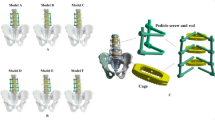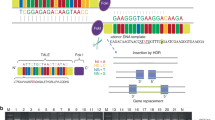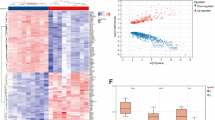Abstract
PITX1 is a bicoid-related homeodomain transcription factor implicated in vertebrate hindlimb development. Recently, mutations in PITX1 have been associated with autosomal-dominant clubfoot. In addition, one affected individual showed a polydactyly and right-sided tibial hemimelia. We now report on PITX1 deletions in two fetuses with a high-degree polydactyly, that is, mirror-image polydactyly. Analysis of DNA from additional individuals with isolated lower-limb malformations and higher-degree polydactyly identified a third individual with long-bone deficiency and preaxial polydactyly harboring a heterozygous 35 bp deletion in PITX1. The findings demonstrate that mutations in PITX1 can cause a broad spectrum of isolated lower-limb malformations including clubfoot, deficiency of long bones, and mirror-image polydactyly.
Similar content being viewed by others
Log in or create a free account to read this content
Gain free access to this article, as well as selected content from this journal and more on nature.com
or
References
Kornak U, Mundlos S : Genetic disorders of the skeleton: a developmental approach. Am J Hum Genet 2003; 73: 447–474.
Stricker S, Mundlos S : Mechanisms of digit formation: human malformation syndromes tell the story. Dev Dyn 2011; 240: 990–1004.
Stevenson RE, Judith G H : Human Malformations and Related Anomalies. New York: Oxford University Press, 2005.
Marino-Enriquez A, Lapunzina P, Omenaca F, Morales C, Rodriguez JI : Laurin-Sandrow syndrome: review and redefinition. Am J Med Genet A 2008; 146A: 2557–2565.
Verghese R, Shah H, Rebello G, Joseph B : Pre-axial mirror polydactyly associated with tibial deficiency: a study of the patterns of skeletal anomalies of the foot and leg. J Child Orthop 2007; 1: 49–54.
Kondoh S, Sugawara H, Harada N et al: A novel gene is disrupted at a 14q13 breakpoint of t(2;14) in a patient with mirror-image polydactyly of hands and feet. J Hum Genet 2002; 47: 136–139.
Gurnett CA, Alaee F, Kruse LM et al: Asymmetric lower-limb malformations in individuals with homeobox PITX1 gene mutation. Am J Hum Genet 2008; 83: 616–622.
Alvarado DM, McCall K, Aferol H et al: Pitx1 haploinsufficiency causes clubfoot in humans and a clubfoot-like phenotype in mice. Hum Mol Genet 2011; 20: 3943–3952.
Klopocki E, Ott CE, Benatar N, Ullmann R, Mundlos S, Lehmann K : A microduplication of the long range SHH limb regulator (ZRS) is associated with triphalangeal thumb-polysyndactyly syndrome. J Med Genet 2008; 45: 370–375.
Semina EV, Reiter R, Leysens NJ et al: Cloning and characterization of a novel bicoid-related homeobox transcription factor gene, RIEG, involved in Rieger syndrome. Nat Genet 1996; 14: 392–399.
Szeto DP, Rodriguez-Esteban C, Ryan AK et al: Role of the Bicoid-related homeodomain factor Pitx1 in specifying hindlimb morphogenesis and pituitary development. Genes Dev 1999; 13: 484–494.
Marcil A, Dumontier E, Chamberland M, Camper SA, Drouin J : Pitx1 and Pitx2 are required for development of hindlimb buds. Development 2003; 130: 45–55.
Minguillon C, Del Buono J, Logan MP : Tbx5 and Tbx4 are not sufficient to determine limb-specific morphologies but have common roles in initiating limb outgrowth. Dev Cell 2005; 8: 75–84.
DeLaurier A, Schweitzer R, Logan M : Pitx1 determines the morphology of muscle, tendon, and bones of the hindlimb. Dev Biol 2006; 299: 22–34.
Logan M, Tabin CJ : Role of Pitx1 upstream of Tbx4 in specification of hindlimb identity. Science 1999; 283: 1736–1739.
Chan YF, Marks ME, Jones FC et al: Adaptive evolution of pelvic reduction in sticklebacks by recurrent deletion of a Pitx1 enhancer. Science 2010; 327: 302–305.
Lanctot C, Moreau A, Chamberland M, Tremblay ML, Drouin J : Hindlimb patterning and mandible development require the Ptx1 gene. Development 1999; 126: 1805–1810.
Kurth I, Klopocki E, Stricker S et al: Duplications of noncoding elements 5′ of SOX9 are associated with brachydactyly-anonychia. Nat Genet 2009; 41: 862–863.
Klopocki E, Mundlos S : Copy-number variations, noncoding sequences, and human phenotypes. Annu Rev Genomics Hum Genet 2011; 12: 53–72.
Hill RE : How to make a zone of polarizing activity: insights into limb development via the abnormality preaxial polydactyly. Dev Growth Differ 2007; 49: 439–448.
Woods CG, Stricker S, Seemann P et al: Mutations in WNT7A cause a range of limb malformations, including Fuhrmann syndrome and Al-Awadi/Raas-Rothschild/Schinzel phocomelia syndrome. Am J Hum Genet 2006; 79: 402–408.
Acknowledgements
We thank the families for their cooperation and participation in this study. This study was supported by a grant to IK by the Fritz-Thyssen-Stiftung and to EK and SM by the Deutsche Forschungsgemeinschaft.
Author information
Authors and Affiliations
Corresponding author
Ethics declarations
Competing interests
The authors declare no conflict of interest.
Additional information
Supplementary Information accompanies the paper on European Journal of Human Genetics website
Supplementary information
Rights and permissions
About this article
Cite this article
Klopocki, E., Kähler, C., Foulds, N. et al. Deletions in PITX1 cause a spectrum of lower-limb malformations including mirror-image polydactyly. Eur J Hum Genet 20, 705–708 (2012). https://doi.org/10.1038/ejhg.2011.264
Received:
Revised:
Accepted:
Published:
Issue date:
DOI: https://doi.org/10.1038/ejhg.2011.264
Keywords
This article is cited by
-
KAT6A mutations in Arboleda-Tham syndrome drive epigenetic regulation of posterior HOXC cluster
Human Genetics (2023)
-
Evolutionary genetics of flipper forelimb and hindlimb loss from limb development-related genes in cetaceans
BMC Genomics (2022)
-
The molecular genetics of human appendicular skeleton
Molecular Genetics and Genomics (2022)
-
Strigea robusta causes polydactyly and severe forms of Rostand’s anomaly P in water frogs
Parasites & Vectors (2020)
-
A simple strategy for heritable chromosomal deletions in zebrafish via the combinatorial action of targeting nucleases
Genome Biology (2013)



